Understanding Hearing Loss
Identifying Asymmetrical Hearing Loss Causes: A Comprehensive Guide
Narrowing down the causes of asymmetrical hearing loss holds the key to unraveling a surprising mystery that impacts 60% of individuals – are you ready to uncover the truth?

As a team, we discovered a surprising fact: approximately 60% of individuals with hearing impairments experience uneven hearing loss.
While this statistic may raise eyebrows, our guide aims to unravel the complexities behind this prevalent issue. By shedding light on various causes and their implications, we lay the groundwork for a deeper understanding of this unique auditory challenge.
Stay tuned to uncover the intricate web of factors contributing to asymmetrical hearing loss and how this guide can offer clarity and guidance in navigating this lesser-known aspect of hearing health.
Key Takeaways
- Meniere's disease and vestibular schwannoma are common causes of asymmetrical hearing loss.
- Genetic factors, aging, head trauma, and loud noises can contribute to varying degrees of hearing loss.
- Ototoxic medications like antibiotics and chemotherapy drugs can damage the auditory system.
- Timely diagnosis, monitoring, and tailored interventions are crucial for managing asymmetric hearing loss effectively.
Understanding Asymmetrical Hearing Loss Causes
When examining the complexities of asymmetrical hearing loss causes, it becomes evident that a range of factors play significant roles in its development. These include Meniere's disease, characterized by inner ear fluid accumulation, which can lead to fluctuating hearing loss. Additionally, vestibular schwannoma, a noncancerous tumor on the main nerve leading from the inner ear to the brain, can also cause asymmetrical hearing loss.
Genetic factors and aging contribute to the gradual deterioration of hearing, often affecting one ear more than the other. Head trauma, exposure to ototoxic medications, loud noises, and infections can damage the auditory system asymmetrically. Understanding these diverse causes is crucial for accurate diagnosis and appropriate management of asymmetrical hearing loss.
Comprehensive medical evaluations are essential to pinpoint the specific underlying factors contributing to this condition.
Common Triggers of Asymmetrical Hearing Loss

Exposure to loud noise, genetic factors, head injuries, ototoxic medications, and tumors are common triggers of asymmetrical hearing loss.
Noise exposure, such as from machinery or concerts, can cause damage to the delicate hair cells in the inner ear, leading to asymmetrical sensorineural hearing loss.
Genetic factors play a significant role, with certain inherited conditions or family history contributing to the development of uneven hearing loss.
Traumatic head injuries, like skull fractures or concussions, can result in varying degrees of hearing loss in each ear, further exacerbating the asymmetry.
Ototoxic medications, including specific antibiotics and chemotherapy drugs, have the potential to induce asymmetrical hearing loss as a side effect by damaging the auditory system.
Additionally, the growth of tumors, such as acoustic neuromas, can affect hearing differently in each ear, leading to asymmetrical hearing loss. Understanding these common triggers is crucial in diagnosing and managing age-related hearing loss effectively.
Genetic Factors in Asymmetrical Hearing Loss
Genetic factors significantly influence the susceptibility and severity of asymmetrical hearing loss, playing a crucial role in the manifestation of varying hearing loss patterns within families. Specific gene mutations have been identified as contributors to the development of asymmetrical hearing loss. Syndromic genetic disorders such as Waardenburg syndrome and Pendred syndrome are known to be associated with asymmetrical hearing loss presentations. Variations in the GJB2 gene have been linked to both bilateral and asymmetrical sensorineural hearing loss, highlighting the complex genetic underpinnings of this condition.
Understanding the genetic basis of asymmetrical hearing loss is essential as it can lead to more personalized treatment approaches. By identifying specific genetic factors, healthcare professionals can tailor interventions to address individual needs effectively. This targeted approach can improve outcomes and enhance the quality of life for individuals with asymmetrical hearing loss. Therefore, genetic evaluations play a crucial role in the management and treatment of this condition.
Ototoxic Medications and Hearing Asymmetry

Utilizing ototoxic medications poses a potential risk for inducing hearing asymmetry due to their damaging effects on the inner ear or auditory nerve. These medications can lead to various degrees of hearing loss or imbalance, ranging from temporary to permanent based on factors such as the specific drug and dosage. Monitoring for signs of hearing impairment while taking ototoxic medications is essential to mitigate the risk of long-term damage. Discussing potential hearing-related side effects with healthcare providers is crucial for patients undergoing treatment with ototoxic medications.
- Ototoxic medications are drugs that damage the inner ear or auditory nerve, potentially causing hearing loss or imbalance.
- Common ototoxic medications include certain antibiotics, chemotherapy drugs, and high doses of aspirin.
- The impact of ototoxic medications on hearing can vary from temporary to permanent, depending on the drug and dosage.
- Monitoring for signs of hearing loss while taking ototoxic medications is crucial to prevent long-term damage.
Health Conditions Linked to Hearing Asymmetry
Health conditions such as Meniere's disease, vestibular schwannoma, congenital stenosis, and shooters ear are all linked to asymmetrical hearing loss, presenting various symptoms and implications requiring specific medical attention.
Meniere's disease manifests with vertigo, tinnitus, and hearing loss, often affecting one ear more than the other.
Vestibular schwannoma, a noncancerous tumor on the vestibulocochlear nerve, can lead to asymmetrical hearing loss along with balance issues.
Congenital stenosis, characterized by a narrow ear canal present from birth, may contribute to hearing asymmetry.
Shooters ear, resulting from exposure to loud firearms, can cause hearing loss that differs between ears due to varying noise exposure levels.
Understanding these health conditions is crucial for identifying potential causes of asymmetrical hearing loss and guiding appropriate medical interventions. Timely diagnosis and management can help mitigate the impact of these conditions on hearing health and overall well-being.
Frequently Asked Questions
What Is the Most Common Cause of Asymmetrical Hearing Loss?
The most common cause of asymmetrical hearing loss is sensorineural hearing loss, impacting the inner ear or auditory nerve. Other contributing factors include aging, genetic predispositions, noise exposure, head injuries, medications that are ototoxic, tumors, infections, and conditions like Ménière's disease.
An evaluation by a healthcare professional is crucial to pinpointing the exact cause of asymmetrical hearing loss. In some instances, familial history may suggest a genetic link to this condition.
What Is the Criteria for Hearing Loss Asymmetry?
We define hearing loss asymmetry as a measurable difference of at least 15 decibels between the ears. This condition is diagnosed when one ear experiences significantly greater hearing loss than the other.
It's crucial to differentiate between asymmetrical hearing loss and unilateral hearing loss, which affects only one ear. Audiologists rely on specific thresholds and measurements to accurately assess and classify the severity of asymmetrical hearing loss.
What Is the Best Hearing Aid for Asymmetrical Hearing Loss?
When it comes to finding the best hearing aid for asymmetrical hearing loss, we need to consider the individual's unique hearing needs and the severity of the impairment in each ear. Binaural hearing aids are often recommended as they provide balanced sound amplification, enhancing overall auditory perception.
These aids can be customized to suit each ear's requirements, ensuring optimal sound quality and clarity. Cochlear implants might be considered for severe cases where traditional aids aren't sufficient.
What Causes Asymmetrical Ears?
Asymmetrical ears can result from various factors, including genetics, congenital conditions, trauma, infections, tumors, or neurological disorders. Structural abnormalities in the ear canal, middle ear, or inner ear can also lead to asymmetrical ears.
Conditions like microtia, anotia, or craniofacial abnormalities may be associated with this issue. To pinpoint the exact cause of asymmetrical ears, imaging studies, genetic testing, or a thorough medical history review may be necessary.
Conclusion
In conclusion, we've uncovered the intricate web of factors that contribute to asymmetrical hearing loss. From genetic predispositions to ototoxic medications, the journey to auditory balance is riddled with twists and turns.
But fear not, dear readers, for armed with knowledge and determination, we can navigate these challenges with grace and resilience. So, let's embrace our asymmetrical ears as unique badges of honor, for they remind us of the fascinating complexity of the human body.
Stay curious, stay informed, and let's conquer hearing asymmetry together.
Taylor brings a dynamic and analytical perspective to the Deaf Vibes team, focusing on research-driven content that educates and informs. With an unquenchable curiosity for new developments, policies, and social issues affecting the deaf and hard-of-hearing community, Taylor’s writing is a crucial resource for readers seeking to navigate these areas. Whether breaking down legal rights, highlighting educational opportunities, or offering guides on accessible technology, Taylor’s work is an invaluable asset to those seeking to empower themselves and others. Taylor’s commitment to accuracy and depth ensures that our readers have access to reliable and actionable information.
Understanding Hearing Loss
How Does Mumps Cause Hearing Loss: A Comprehensive Guide
Lurking within the mumps virus lies a surprising link to hearing loss, uncovering a mysterious connection worth exploring further.
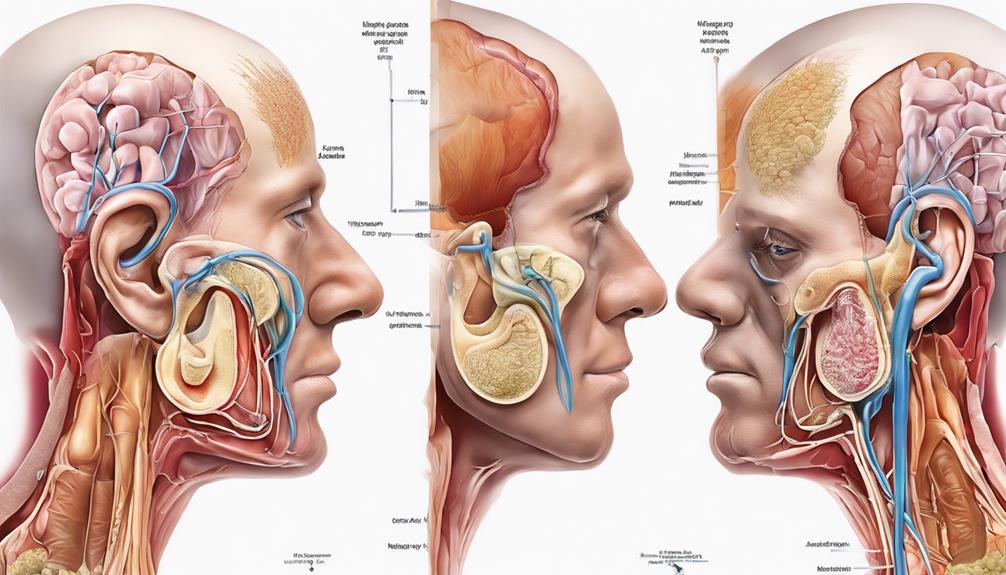
In the realm of medical mysteries, the link between mumps and hearing impairment remains an enigmatic puzzle waiting to be unraveled.
As we explore the intricate mechanisms behind this connection, a deeper understanding emerges, shedding light on the complexities of how mumps can lead to profound auditory impairment.
The journey into this realm of viral-induced deafness promises insights that may challenge preconceived notions and offer a fresh perspective on the interplay between infectious diseases and sensory functions.
Key Takeaways
- Mumps damages inner ear structures, causing sensorineural hearing loss.
- Mumps can lead to unilateral and profound deafness post-infection.
- Hearing loss post-mumps is often permanent and affects the cochlea and auditory nerve.
- Early recognition of mumps-induced unilateral hearing loss is crucial for timely intervention.
Mechanisms of Mumps-Related Hearing Loss
Understanding how the mumps virus damages the inner ear and disrupts auditory function is crucial in elucidating the mechanisms behind mumps-related hearing loss. When the mumps virus infiltrates the inner ear, it targets key structures such as the cochlea and auditory nerve, leading to potential hearing impairment.
The cochlea, responsible for translating sound vibrations into electrical signals, is particularly vulnerable to mumps-induced damage. This virus can directly invade the cochlea, causing harm to the delicate hair cells essential for detecting sound frequencies. As a consequence, the transmission of auditory signals to the brain is hindered, resulting in sensorineural deafness.
Mumps-related hearing loss is often unilateral, affecting one ear more severely than the other. Unfortunately, the damage inflicted by the mumps virus on the inner ear is usually irreversible due to the limited regenerative capacity of inner ear cells. Therefore, understanding the intricate mechanisms through which mumps wreaks havoc on the inner ear sheds light on the pathophysiology of mumps-induced hearing loss.
Impact of Mumps on Auditory System
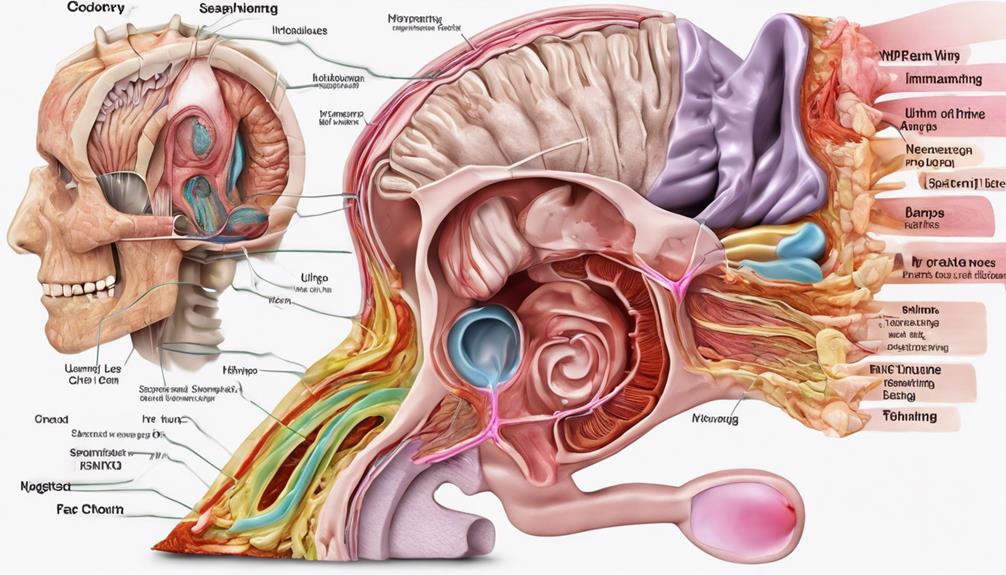
When the mumps virus infiltrates the inner ear, it can lead to sudden, profound, and typically unilateral sensorineural hearing loss in children, highlighting the significant impact of mumps on the auditory system. The mumps virus likely invades the inner ear hematogenously, causing viral endolymphatic labyrinthitis, a condition that can result in complications such as hearing loss. Studies estimate that approximately 1 in 20,000 mumps cases lead to deafness post-infection. MRI evidence has shown that the labyrinthine and eighth-nerve bundle are involved in mumps virus-induced sudden deafness and vertigo. This direct impact on the auditory system underscores the importance of understanding the potential consequences of mumps beyond the typical symptoms. Below is a table summarizing key points related to the impact of mumps on the auditory system:
| Keyword | Description |
|---|---|
| Labyrinthitis | Inflammation of the inner ear caused by the mumps virus invasion |
| Unilateral | Typically affecting only one ear |
| MRI Evidence | Shows involvement of labyrinthine and eighth-nerve bundle in mumps-induced sudden deafness/vertigo |
Long-Term Effects on Hearing From Mumps
Long-term effects on hearing resulting from mumps infection may include permanent sensorineural hearing loss, predominantly affecting the cochlea and auditory nerve. The damage caused by the mumps virus to the inner ear structures can lead to lasting impairment in auditory function.
This type of hearing loss is often unilateral, impacting one ear more severely than the other. Individuals who experience hearing loss post-mumps may face sudden and profound decreases in their ability to perceive sounds.
Research suggests that the incidence of deafness following mumps infection is relatively rare, estimated at around 1 in 20,000 cases. To address potential complications and manage the long-term effects on hearing, regular monitoring through comprehensive audiological examinations is crucial.
Recognizing Mumps-Induced Hearing Impairment
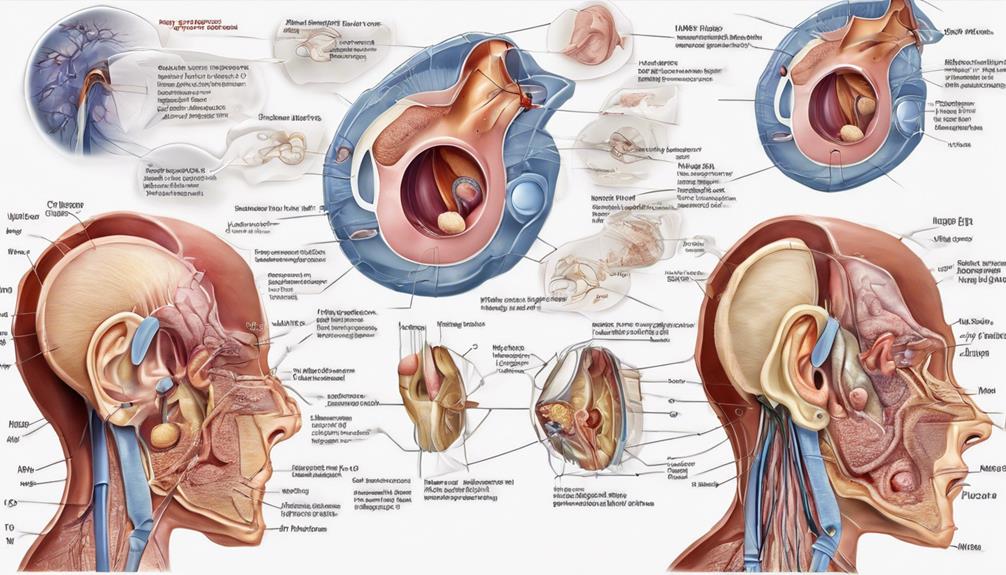
Mumps-induced hearing impairment, often striking children suddenly and profoundly, typically manifests unilaterally. When recognizing mumps-induced hearing impairment, consider the following:
- Unilateral Presentation: Mumps-related hearing loss commonly affects one ear, distinguishing it from other causes of deafness.
- Vestibular Symptoms: Presence of balance issues or vertigo alongside hearing loss may suggest inner ear involvement due to mumps infection.
- Sensorineural Nature: The deafness post-mumps is often sensorineural, affecting the inner ear's ability to transmit sound signals to the brain.
- Hematogenous Route: Studies propose that the mumps virus invades the inner ear through the bloodstream, leading to labyrinthitis and subsequent deafness.
Understanding these key points can aid in early identification and appropriate management of mumps-induced hearing impairment. By recognizing the unilateral nature, potential vestibular symptoms, sensorineural characteristics, and the hematogenous route of viral invasion, healthcare providers can promptly address mumps-related deafness to prevent long-term complications.
Addressing Complications of Mumps-Related Deafness
Addressing complications arising from mumps-related deafness requires vigilant monitoring and prompt intervention to mitigate potential long-term consequences. After mumps infection, complications such as sensorineural hearing loss can have a significant impact on an individual's quality of life. Here, we delve into the management strategies for these complications:
| Complication | Management |
|---|---|
| Sensorineural Hearing Loss | Regular audiograms to monitor hearing thresholds. |
| Cochlea Damage | Consideration of cochlear implants for severe cases. |
| Auditory Nerve Damage | Rehabilitation with speech therapy and hearing aids. |
| Brainstem Involvement | Neurological assessments for potential central issues. |
| Vestibular Symptoms | Vestibular rehabilitation therapy for balance issues. |
Monitoring hearing loss post-mumps is crucial due to the potential for permanent damage to the auditory system. Management strategies aim to optimize hearing function and address any vestibular symptoms that may arise. By staying proactive in monitoring and managing these complications, individuals can navigate mumps-related deafness more effectively.
Frequently Asked Questions
How Do the Mumps Cause Hearing Loss?
Mumps cause hearing loss by damaging the inner ear structures, like the cochlea and auditory nerve.
The virus can harm delicate hair cells in the cochlea, affecting sound signal transmission to the brain.
Unfortunately, mumps-related hearing loss is typically irreversible due to limited inner ear cell repair capacity.
Permanent sensorineural hearing loss can result from damage to the auditory nerve and cochlea, making vaccination crucial for prevention, especially in unvaccinated individuals.
How Does Rubella Cause Hearing Loss?
Rubella, a viral infection, can lead to sensorineural hearing loss in newborns if contracted by the mother during pregnancy. This condition, known as congenital rubella syndrome (CRS), can result in permanent bilateral hearing loss, particularly affecting high frequencies.
The risk of hearing impairment in infants with CRS is approximately 50% if the mother is infected during the first trimester. Rubella vaccination, such as in the MMR vaccine, is essential to prevent CRS and associated hearing loss.
What Is the Mumps Behind the Ear?
Behind the ear, mumps refers to the swelling of the parotid glands due to mumps infection. This inflammation causes pain, tenderness, and visible swelling extending to the jawline. Monitoring this swelling is crucial for tracking mumps progression and potential complications like hearing loss.
It's a characteristic symptom aiding in mumps diagnosis. Treatment focuses on managing symptoms and preventing complications. Regular medical follow-ups are essential for effective mumps management and recovery.
What Damage Can Mumps Cause?
When mumps strikes, the damage it inflicts is no joke. This viral menace can wreak havoc on our inner ear, specifically targeting the cochlea and auditory nerve.
The delicate hair cells within the cochlea are particularly at risk, leading to potential hearing loss. Unfortunately, the harm caused by mumps to our auditory system is often irreversible, leaving us grappling with the consequences for the long haul.
Conclusion
In conclusion, mumps can be likened to a stealthy intruder, silently infiltrating the delicate auditory system and wreaking havoc on a child's ability to hear. The labyrinthine and eighth-nerve bundle become battlegrounds in the war against sudden, profound deafness.
Vigilance, through vaccination and prompt medical intervention, is our strongest defense against the silent threat of mumps-induced hearing loss. Let's stand guard, armed with knowledge and action, to protect our children's precious gift of sound.
Taylor brings a dynamic and analytical perspective to the Deaf Vibes team, focusing on research-driven content that educates and informs. With an unquenchable curiosity for new developments, policies, and social issues affecting the deaf and hard-of-hearing community, Taylor’s writing is a crucial resource for readers seeking to navigate these areas. Whether breaking down legal rights, highlighting educational opportunities, or offering guides on accessible technology, Taylor’s work is an invaluable asset to those seeking to empower themselves and others. Taylor’s commitment to accuracy and depth ensures that our readers have access to reliable and actionable information.
Understanding Hearing Loss
How White Noise Can Cause Hearing Loss: A Comprehensive Guide
Delve into the hidden dangers of white noise and its impact on hearing health, uncovering a surprising connection that demands attention.
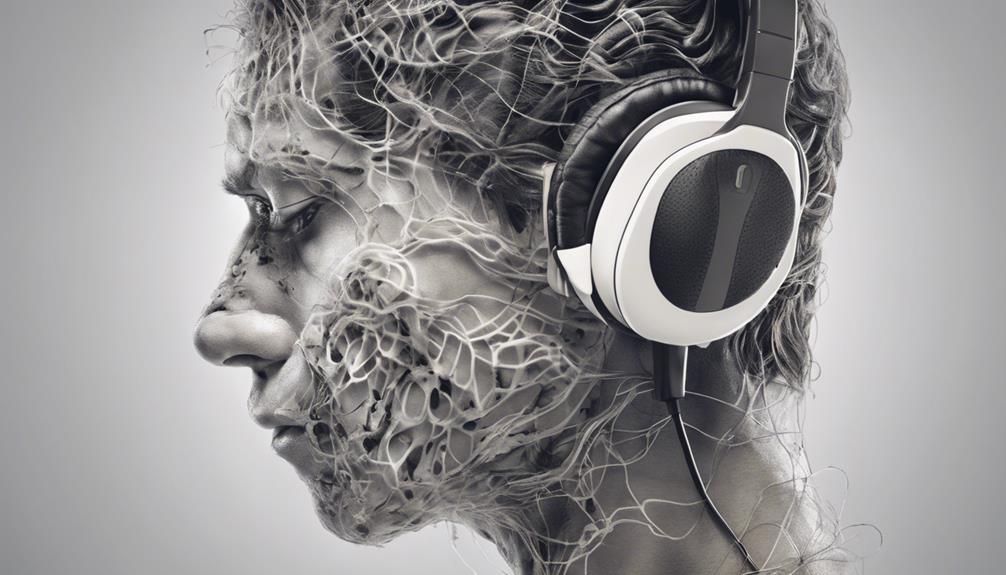
Amidst the busy pace of modern life, the subtle yet pervasive impact of white noise on our hearing often goes unnoticed. Despite seeming harmless on the surface, there may be a potential threat to our hearing health lurking beneath.
Exploring how white noise can inadvertently lead to hearing loss unveils a complex relationship between sound and our delicate auditory system. Unraveling the intricacies of this phenomenon is not only enlightening but also imperative for safeguarding our hearing health in the face of ubiquitous noise exposure.
Key Takeaways
- White noise exposure can lead to irreversible hearing loss.
- High-intensity white noise damages delicate inner ear hair cells.
- Prolonged white noise exposure causes gradual hearing degradation.
- Strategies like ear protection and limiting exposure help prevent white noise-induced hearing damage.
Understanding White Noise and Its Impact
White noise, a sound characterized by its equal energy distribution across all frequencies, has a significant impact on auditory perception and cognitive processes. Exposure to high levels of white noise can potentially lead to hearing loss. The auditory nerve and inner ear are particularly vulnerable to damage from prolonged noise exposure. This type of noise exposure can cause irreversible harm to our hearing capabilities.
To prevent hearing loss due to white noise exposure, it's crucial to limit the duration and intensity of exposure. Implementing soundproofing measures in noisy environments and using ear protection devices can also help mitigate the risk of hearing damage. Understanding the mechanisms by which white noise affects our auditory system is essential in safeguarding our hearing health.
Mechanism of Hearing Damage

Excessive exposure to high-intensity noise, particularly white noise, can intricately damage the delicate hair cells within the inner ear, leading to gradual hearing loss over time. The inner ear houses the cochlea, a spiral-shaped organ responsible for converting sound vibrations into electrical signals that the brain can interpret.
When subjected to prolonged exposure to intense white noise, the hair cells within the cochlea can become overstimulated and eventually start to degenerate. This process disrupts the normal function of the auditory system, affecting the transmission of sound signals to the brain and resulting in hearing loss.
The damage caused by white noise isn't limited to the cochlea but can also extend to the auditory nerve, further compromising the ability to perceive sounds accurately. Understanding the mechanism by which white noise harms the delicate structures of the inner ear underscores the importance of protecting our hearing health by minimizing exposure to high-intensity noise.
Effects on Hearing Thresholds
Intense exposure to white noise can impact hearing thresholds, potentially leading to temporary changes in auditory sensitivity. Prolonged or intense exposure to high levels of white noise can cause temporary threshold shifts, affecting how we perceive sounds. This effect is often reversible but can become permanent with continued exposure to loud sounds. To highlight the impact of white noise on hearing thresholds, consider the table below:
| Effects of White Noise on Hearing Thresholds | Examples |
|---|---|
| Temporary Hearing Changes | Temporary threshold shifts after exposure to loud white noise. |
| Permanent Hearing Damage | Continued exposure leading to permanent hearing loss. |
| Use of Hearing Aids | Necessary for individuals experiencing permanent hearing damage. |
| Prevention Strategies | Limiting exposure to loud white noise sources. |
Understanding how white noise can affect hearing thresholds is crucial in preventing potential hearing damage. By recognizing the risks associated with overexposure to white noise, individuals can take proactive measures to protect their auditory health.
Difference Between Noise Types

Exploring the spectrum of different types of noise, such as white, pink, and brown, offers valuable insights into their distinct characteristics and applications.
White noise, with its equal distribution of frequencies, is commonly used for masking background sounds.
Pink noise, on the other hand, features a different frequency distribution that reduces higher frequencies and boosts lower frequencies.
Brown noise stands out due to its power spectral density being inversely proportional to frequency squared, creating a unique sound profile.
The distinct frequency profiles of these noise types influence their effectiveness in various scenarios. Continuous exposure to any of these noises can potentially lead to hearing loss over time.
When considering the impact on hearing, different types of hearing tests can assess the specific type of hearing loss that may result from prolonged exposure.
Understanding how these noises affect the delicate structures inside the cochlea is crucial in preventing long-term damage and maintaining healthy hearing abilities.
Tips for Hearing Protection
To protect your hearing effectively, it is essential to implement practical strategies that reduce exposure to damaging noise levels. Here are some tips for hearing protection:
| Hearing Protection Tips | Description |
|---|---|
| Wear earplugs or earmuffs | Reduce exposure to loud noises in environments such as concerts, construction sites, or clubs. |
| Take breaks from loud activities | Give your ears time to rest and recover, especially after prolonged exposure to loud sounds. |
| Keep a safe distance from noise sources | Minimize the intensity of sound reaching your ears by maintaining a safe distance from loud sources. |
| Limit duration of exposure | Prevent long-term damage by limiting the time spent in environments with high noise levels. |
Additionally, it's crucial to prioritize your hearing health by scheduling regular hearing check-ups. These assessments can help monitor changes in your ability to hear, detect early signs of hearing impairment, and address any concerns promptly. By combining these protective measures and proactive steps, you can safeguard your hearing abilities and reduce the risk of noise-induced hearing damage significantly.
Frequently Asked Questions
Can a White Noise Machine Cause Hearing Loss?
Yes, a white noise machine can cause hearing loss if used improperly. Exposure to high volumes of white noise over extended periods can damage the inner ear structures, potentially leading to temporary or permanent hearing loss.
It's crucial to monitor the volume levels and duration of white noise exposure to protect our hearing health. Being mindful of these factors can help prevent negative consequences associated with white noise machine usage.
Why Is White Noise Bad for You?
White noise is detrimental to our health because it can lead to hearing loss. Exposure to high volumes of white noise can damage our auditory system over time.
This type of noise can mask important sounds, causing us to raise the volume to unsafe levels. Continuous exposure can result in cochlear damage and difficulties in hearing.
It's essential to be mindful of the impact of white noise on our hearing health to prevent long-term damage.
Is It OK to Leave White Noise on All Night?
Yes, it's generally safe to leave white noise on all night, but it's crucial to be mindful of the volume level. Prolonged exposure to loud sounds, like white noise, can potentially lead to hearing loss over time.
Monitoring the volume and seeking guidance from a healthcare professional or audiologist on safe usage practices is essential for protecting our hearing health.
Should I Listen to White Noise While Sleeping?
Yes, we should consider listening to white noise while sleeping as it can mask disruptive sounds and improve sleep quality. White noise creates a consistent background sound aiding in relaxation and sleep onset, especially in noisy environments.
However, it's crucial to use it at safe volume levels and for appropriate durations to prevent potential hearing issues. Proper usage can provide sleep benefits without compromising hearing health.
Conclusion
In conclusion, it's important to be mindful of the potential impact of white noise on our hearing health.
While white noise can provide relaxation and aid in sleep, it's crucial to consider the potential risks associated with prolonged exposure.
By implementing appropriate hearing protection measures and being aware of the effects of different types of noise, we can better safeguard our auditory well-being for the future.
Taylor brings a dynamic and analytical perspective to the Deaf Vibes team, focusing on research-driven content that educates and informs. With an unquenchable curiosity for new developments, policies, and social issues affecting the deaf and hard-of-hearing community, Taylor’s writing is a crucial resource for readers seeking to navigate these areas. Whether breaking down legal rights, highlighting educational opportunities, or offering guides on accessible technology, Taylor’s work is an invaluable asset to those seeking to empower themselves and others. Taylor’s commitment to accuracy and depth ensures that our readers have access to reliable and actionable information.
Understanding Hearing Loss
Wearing AirPods: Can They Cause Hearing Loss?
Worried about your AirPods and hearing loss? Discover the hidden risks and surprising effects that might make you reconsider their usage.
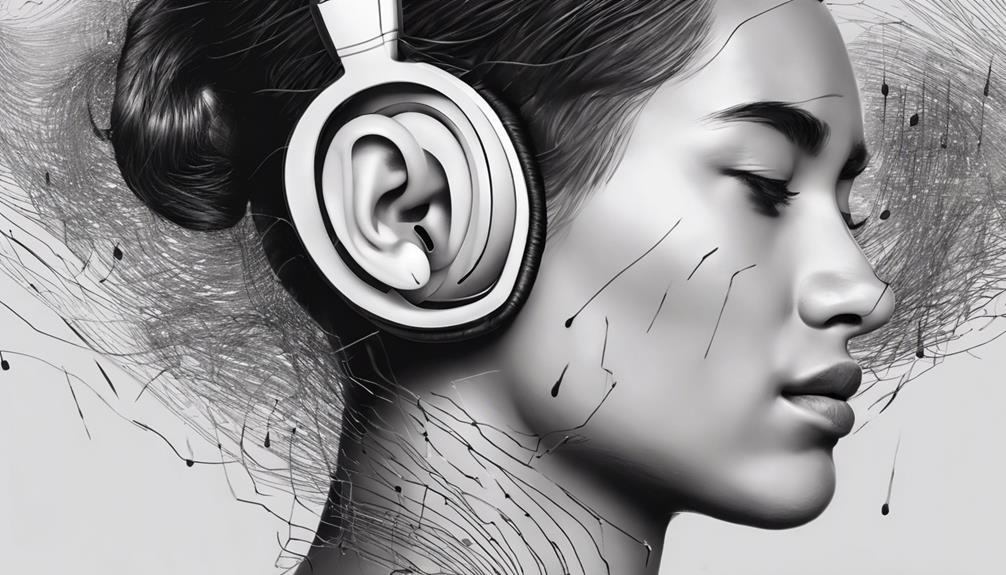
When it comes to using AirPods, it is important to consider the impact they may have on our hearing. Many of us rely on these convenient devices for our daily audio needs, but what if it turns out that there are potential risks associated with prolonged use?
Let's explore the lesser-known effects of wearing AirPods and how it could be affecting our ear health in ways we might not have realized.
Key Takeaways
- Prolonged AirPods use at high volumes can lead to irreversible hearing damage.
- Monitoring volume levels and usage time is crucial for preventing hearing loss.
- Symptoms like tinnitus signal potential hearing issues from excessive noise exposure.
- Adhering to WHO guidelines on safe listening limits protects against long-term hearing harm.
Potential Risks of Prolonged AirPods Use
Prolonged use of AirPods at high volumes poses a significant risk of potential hearing loss due to excessive noise exposure. Research indicates that exposing our ears to loud sounds for extended periods can lead to irreversible hearing damage. When it comes to AirPods, excessive use without adhering to safe listening practices can amplify this risk. The World Health Organization recommends limiting the volume to 85 decibels for no more than 8 hours to prevent hearing damage from headphone use.
Symptoms such as temporary hearing loss and tinnitus (ringing in the ears) can serve as warning signs of potential hearing issues caused by AirPods. It's crucial to monitor the volume levels when using these devices and take regular breaks to give our ears a rest. By tracking our usage patterns and being mindful of how long we wear AirPods, we can significantly reduce the discomfort and long-term hearing damage associated with improper use.
Understanding Decibel Levels and AirPods

To grasp the potential risks associated with AirPods usage, understanding decibel levels is essential in safeguarding our hearing health. Decibels measure sound intensity, and AirPods can reach levels that may cause hearing damage, especially when combined with high background noise.
Here are some key points to consider:
- AirPods users may unknowingly expose themselves to high decibel levels due to environmental noise.
- Monitoring AirPods decibel levels is crucial to prevent exceeding safe listening thresholds.
- Understanding safe listening ranges, typically in the 60s or 70s dB, can protect against hearing loss.
- High background noise can mask the actual loudness of AirPods, leading to potential risks for hearing damage.
- Adjusting listening habits and being aware of the sound levels in our surroundings can help mitigate the impact of high decibel levels on our hearing health.
Being mindful of decibel levels and our listening habits while using AirPods is key to preserving our hearing acuity and preventing long-term damage.
Impact of AirPods on Hearing Health
The impact of AirPods on hearing health is significant, especially when used at high volumes for extended periods. Prolonged exposure to loud sounds from AirPods can result in hearing loss, as the delicate structures in our ears can be damaged by excessive noise. The World Health Organization (WHO) recommends safe noise levels to prevent hearing damage caused by prolonged AirPods usage, emphasizing the importance of protecting our hearing. Symptoms like ringing in the ears can indicate temporary hearing loss due to high AirPods volume, highlighting the need to be mindful of our listening habits. Monitoring our AirPods usage and being aware of volume levels can help prevent discomfort and potential hearing issues. Seeking advice from a professional on safe AirPods usage is crucial, especially for individuals with existing hearing loss, to ensure we protect our hearing for the long term.
| AirPods | Hearing Loss | High Volumes |
|---|---|---|
| Can lead to hearing loss | Excessive noise exposure | Prolonged exposure at loud volumes |
| WHO recommends safe noise levels | Prevent hearing damage | Importance of protecting hearing |
| Ringing in ears as a symptom | Temporary hearing loss | Need to monitor volume levels |
| Consulting professionals advised | Especially for those with hearing loss | Ensure long-term hearing health |
Tips for Protecting Your Hearing With Airpods
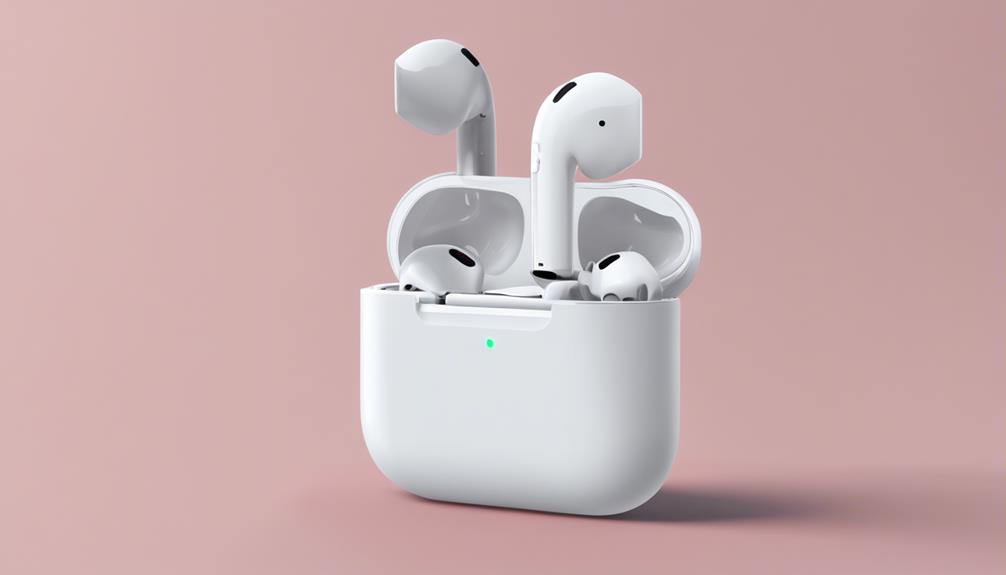
For optimal hearing health when using AirPods, it's essential to adhere to recommended volume levels and take regular breaks to prevent potential hearing damage. Listening at high volumes for extended periods can lead to hearing loss, so following guidelines is crucial. Here are some tips for protecting your hearing while using AirPods:
- Keep AirPods volume below 60% to reduce the risk of damage.
- Take regular breaks from using AirPods to prevent temporary or permanent hearing loss.
- Monitor daily AirPods usage time and volume levels to ensure they're within safe limits.
- Pay attention to symptoms like ringing in the ears, as they can indicate potential hearing damage.
- Consider using noise-cancelling features or apps to reduce the need for high volumes.
Comparing Safety: Airpods Vs. Over-Ear Headphones
When comparing the safety aspects of AirPods and over-ear headphones, it's important to consider the differences in sound isolation and potential impact on ear health.
Over-ear headphones excel in providing superior sound isolation compared to AirPods, effectively reducing direct exposure to the eardrums. This is primarily due to the larger design of over-ear headphones, which helps in lowering the relative decibel levels reaching the ears.
Additionally, the incorporation of noise-canceling technology in over-ear headphones offers robust capabilities for immersive sound experiences without compromising ear safety. However, it's crucial to use the noise-canceling features judiciously to prevent excessive volume exposure that could lead to hearing damage.
Therefore, balancing the convenience of AirPods with the responsible usage of over-ear headphones is essential for safeguarding ear health. Making an informed choice based on these factors can contribute significantly to maintaining optimal ear health while enjoying audio content.
Frequently Asked Questions
Can Wearing Airpods Affect Your Hearing?
Yes, wearing AirPods can affect your hearing. The high volumes emitted by AirPods can potentially lead to hearing loss over time. It's crucial to be mindful of the volume levels to prevent damage.
Symptoms like tinnitus may indicate damage. Regular monitoring and seeking professional advice if experiencing issues are essential.
Protecting our hearing by being cautious with AirPod usage is vital for long-term auditory health.
Is It Bad to Have Airpods at Full Volume?
We should avoid using AirPods at full volume as it can harm our hearing. Listening at high levels for extended periods may cause temporary or permanent damage.
World Health Organization suggests keeping the volume around 60% and limiting usage to an hour daily to safeguard our ears. Overexposure can lead to conditions like tinnitus.
Being cautious with volume and taking breaks can prevent long-term hearing issues.
What Are the Side Effects of Using Earbuds?
Using earbuds for extended periods can lead to hearing issues like tinnitus or even permanent damage. Excessive volume levels are particularly risky. To safeguard our hearing health, it's vital to be mindful of our headphone use.
WHO advises limiting headphone exposure to prevent potential harm. Monitoring volume levels, taking breaks, and being cautious with how we use earbuds can all contribute to maintaining healthy hearing.
Is Wearing One Airpod Bad for Your Ears?
Wearing one AirPod can lead to imbalanced sound exposure and potentially cause hearing damage in the overused ear. To prevent this, we should aim to use both AirPods to ensure a balanced sound experience.
Alternating between ears or using both AirPods helps maintain equal sound exposure, safeguarding our hearing health. Balancing our usage can protect our ears and offer a more enjoyable listening experience.
Conclusion
In conclusion, while using AirPods can enhance our listening experience, it's crucial to be mindful of the potential risks they pose to our hearing health. By understanding decibel levels, taking breaks, and keeping volumes at safe levels, we can enjoy our AirPods responsibly.
Some may argue that AirPods are no different from traditional headphones, but the proximity of AirPods to our eardrums can increase the risk of hearing damage. It's important to prioritize our ear health while enjoying the convenience of wireless earbuds.
Taylor brings a dynamic and analytical perspective to the Deaf Vibes team, focusing on research-driven content that educates and informs. With an unquenchable curiosity for new developments, policies, and social issues affecting the deaf and hard-of-hearing community, Taylor’s writing is a crucial resource for readers seeking to navigate these areas. Whether breaking down legal rights, highlighting educational opportunities, or offering guides on accessible technology, Taylor’s work is an invaluable asset to those seeking to empower themselves and others. Taylor’s commitment to accuracy and depth ensures that our readers have access to reliable and actionable information.
-

 Navigating the VA System4 weeks ago
Navigating the VA System4 weeks agoVA Hearing Loss Rating Chart: Understanding Disability Compensation
-

 Therapies and Interventions3 months ago
Therapies and Interventions3 months ago10 Auditory Processing Goals for Effective Speech Therapy
-

 Living with Hearing Loss2 months ago
Living with Hearing Loss2 months ago10 Deaf-Friendly Dating Sites to Find Your Perfect Match
-

 Sign Language3 months ago
Sign Language3 months agoSign Language Emoji Translator: How to Communicate With Gestures
-

 Tinnitus1 month ago
Tinnitus1 month agoVA's Rating System for Tinnitus and Hearing Loss Explained
-

 Navigating the VA System3 weeks ago
Navigating the VA System3 weeks agoUnderstanding Bilateral Hearing Loss VA Rating Criteria
-

 Vetted1 month ago
Vetted1 month ago15 Best Oticon Hearing Aids to Improve Your Hearing in 2024
-

 Living with Hearing Loss2 months ago
Living with Hearing Loss2 months agoAn Introduction to Deaf Culture: Understanding the Basics




















